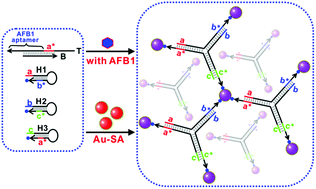An enzyme-free catalytic DNA circuit for amplified detection of aflatoxin B1 using gold nanoparticles as colorimetric indicators†
Abstract
An enzyme-free biosensor for the amplified detection of aflatoxin B1 has been constructed based on a catalytic DNA circuit. Three biotinylated hairpin DNA probes (H1, H2, and H3) were designed as the assembly components to construct the sensing system (triplex H1–H2–H3 product). Cascaded signal amplification capability was obtained through toehold-mediated strand displacement reactions to open the hairpins and recycle the trigger DNA. By the use of streptavidin-functionalized gold nanoparticles as the signal indicators, the colorimetric readout can be observed by the naked eye. In the presence of a target, the individual nanoparticles (red) aggregate into a cross-linked network of nanoparticles (blue) via biotin–streptavidin coupling. The colorimetric assay is ultrasensitive, enabling the visual detection of trace levels of aflatoxin B1 (AFB1) as low as 10 pM without instrumentation. The calculated limit of detection (LOD) is 2 pM in terms of 3 times standard deviation over the blank response. The sensor is robust and works even when challenged with complex sample matrices such as rice samples. Our sensing platform is simple and convenient in operation, requiring only the mixing of several solutions at room temperature to achieve visible and intuitive results, and holds great promise for the point-of-use monitoring of AFB1 in environmental and food samples.


 Please wait while we load your content...
Please wait while we load your content...